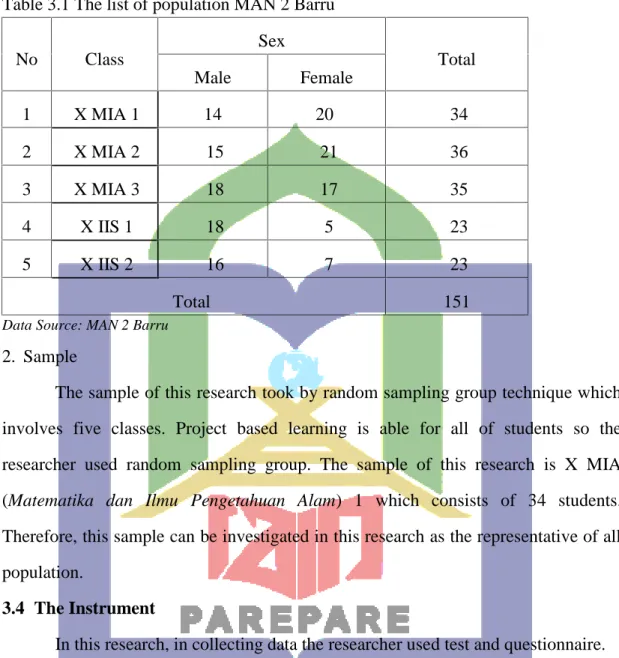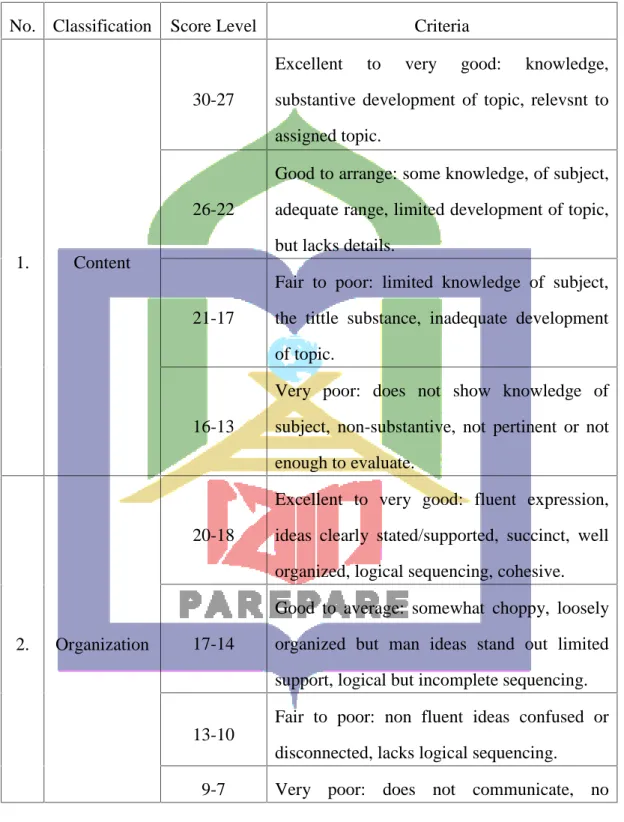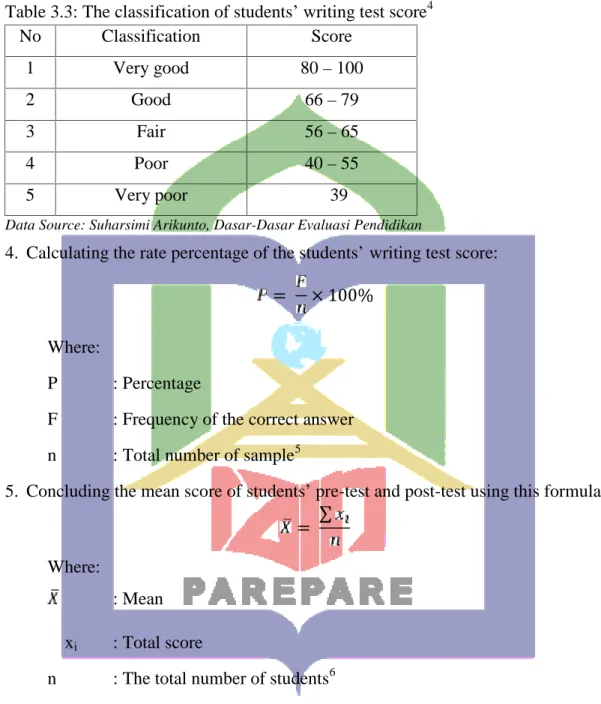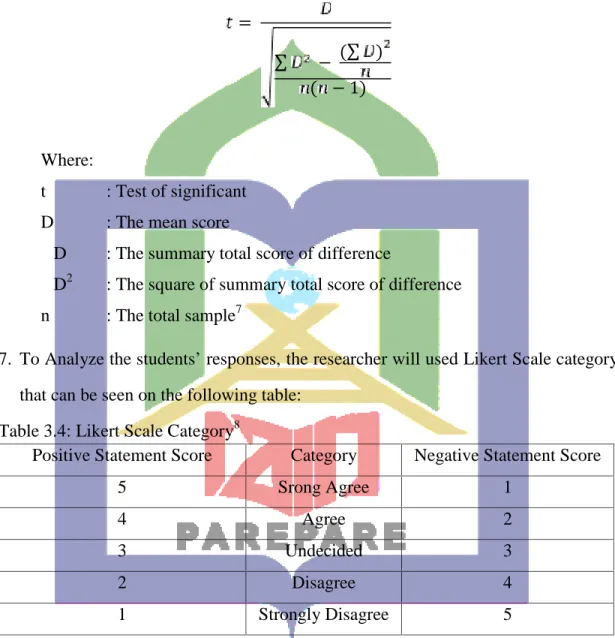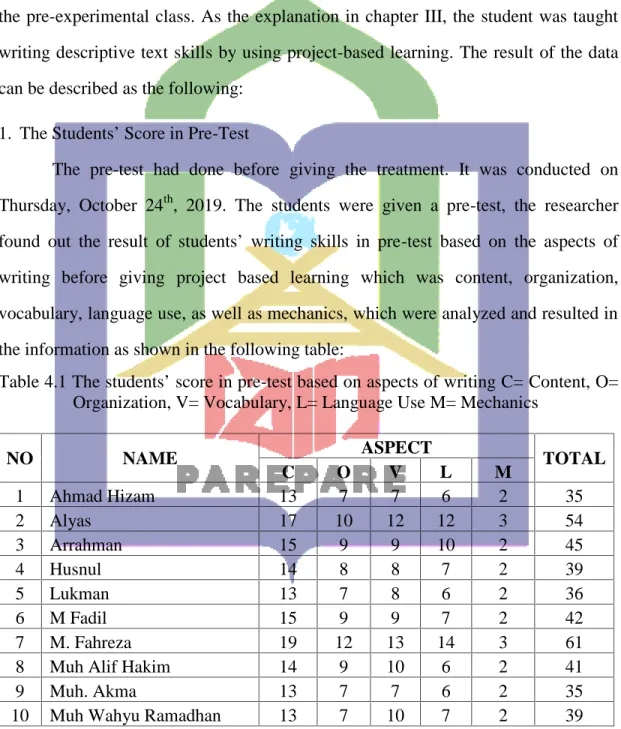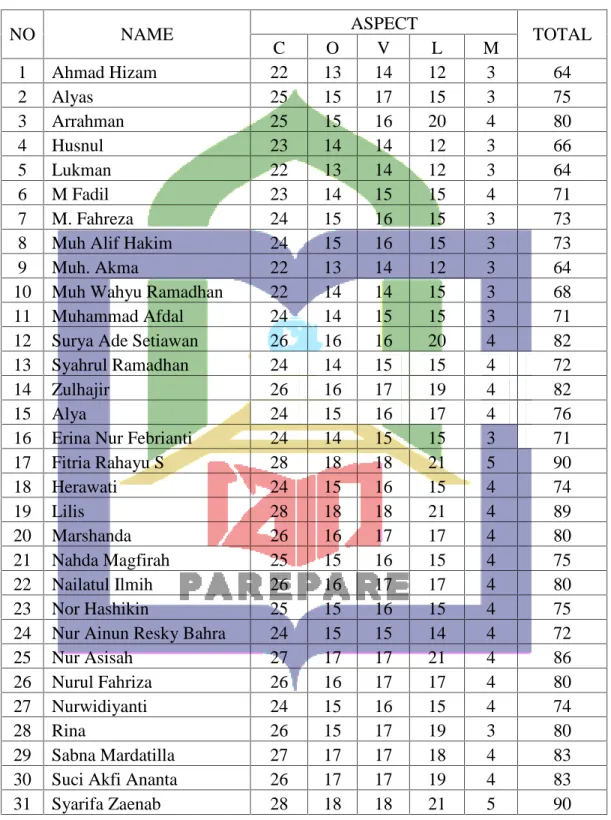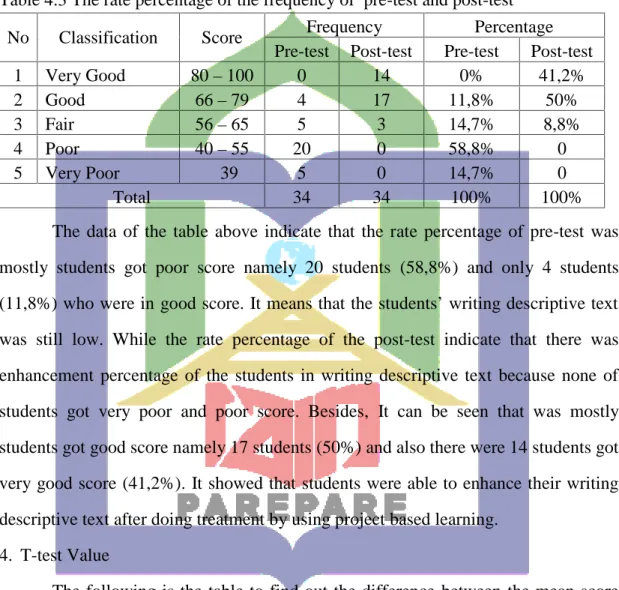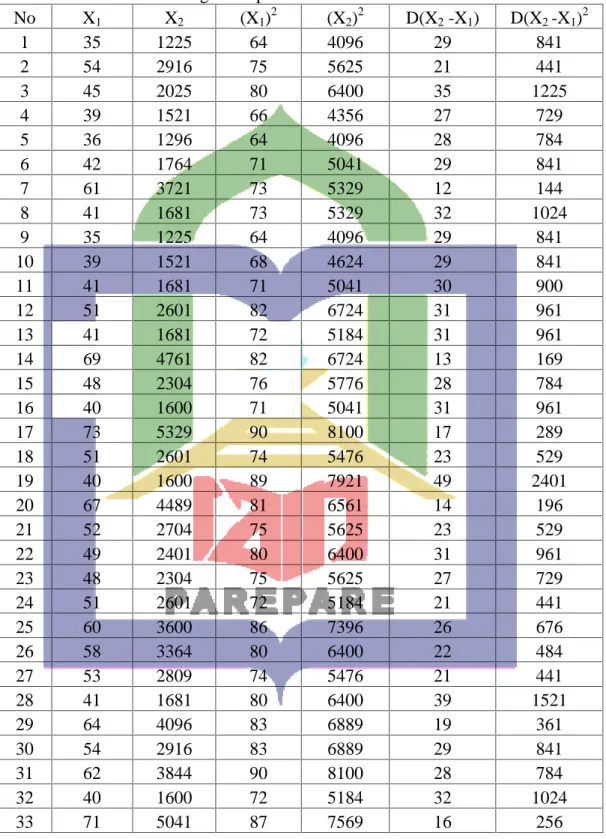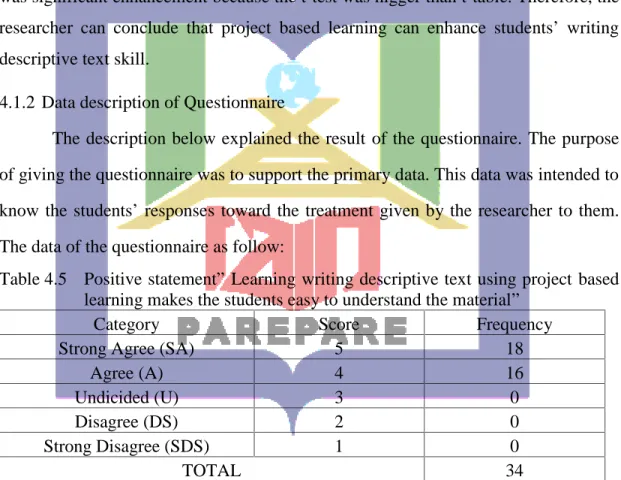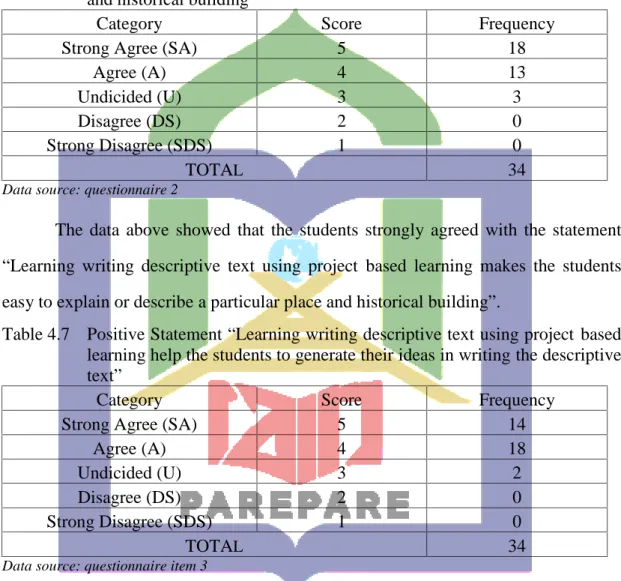PROJECT BASED LEARNING (PBL)
By
NUR FADHILA TUL QUR’AN Reg. Num. 15.1300.035
ENGLISH EDUCATION PROGRAM TARBIYAH FACULTY
STATE ISLAMIC INSTITUTE (IAIN) PAREPARE
2020
ii
By
NUR FADHILA TUL QUR’AN Reg. Num. 15.1300.035
Submitted to the English Program of Faculty of State Islamic Institute of Parepare in Partial of Fulfillment of the Requirements for the Degree
Sarjana Pendidikan (S.Pd)
ENGLISH EDUCATION PROGRAM TARBIYAH FACULTY
STATE ISLAMIC INSTITUTE (IAIN) PAREPARE
2020
iii Skripsi
As Partial Fulfillment of the Requirements for the Degree of Sarjana Pendidikan (S.Pd)
English Education Program
Submitted by
NURFADHILA TUL QUR’AN Reg. Num. 15.1300.035
to
ENGLISH EDUCATION PROGRAM TARBIYAH FACULTY
STATE ISLAMIC INSTITUTE (IAIN) PAREPARE
2020
vii
ِﻢْﯿ ِﺣ ﱠﺮﻟا ِﻦﻤْﺣ ﱠﺮﻟا ِﷲ ِﻢْﺴ ِﺑ
Alhamdulillah, first of all the reserarcher would like to say a lot of thanks to Allah swt for guidance, love and blessing help so that the writer could finish this skripsi. Shalawat and salam to our beloved prophet Muhammad saw, as the last massenger of Allah swt.
In arranging this research, a lot to all people have provided motivation, advice, and support for the researcher. In this valuable chance, the researcher intended to express her gratitude and appreciation to all of them. She realizes that without their support and help, she could not be able to finish this “Skripsi”. So In this opportunity, the writer would like to express especially thanks to her beloved parents and family who have given their endless love, advice, support and pray to God for researcher’s success.
Her high appreciation and profusely sincere thanks are due to Hj. Nurhamdah, S.Ag., M.Pd as the first consultant and Mujahidah, M.Pd. as the second consultant who have patiently guided and given their construction suggestion, motivated and corrected to the researcher for finishing this skripsi.
Besides, the researcher would also deliver special thanks to:
1. The greatest thanks the researcher addressed to her beloved parents Haruna and Sutarni. For their incredible patient, for their endless love, amazing motivation and support, her sister Nurrahmatul Jannah, her young brothers Muhammad Zulkifli and Muhammad Abdillah.
2. Dr. Ahmad Sultra Rustan, M.Si. as the Rector of IAIN Parepare who has worked hard to manage education at IAIN Parepare
viii to the students.
5. Drs. Amzah, M.Pd as an academic advisor who has given advice and motivation to the researcher.
6. All lecturers of English Education who have already taught the researcher during her study in IAIN Parepare.
7. Dra. Hj. Rosnawati Buhari, MM as the headmaster of MAN 2 Barru who has allowed the researcher to conduct and observe the research at the school.
8. Ellyati Razak, S.Ag., M.Pd as the English Teacher of MAN 2 Barru who has given the researcher advices and change in teaching and doing the research.
9. All of students at X MIA 1 of MAN 2 Barru as the sample of the research.
10. Her best friends, Harlina, Norzulya Aries, Hadijah, Nur Hikma, Riska Afriyanti Hasman, Evi Karmila, Hasnidar, Rabiatul Adawiyah, Nirwana, Mardhatillah, and Nursiah who always accompany her start from the first semester until now and always give their support and courage as well as their helping for finishing this research.
11. Thanks also to Hikmah, Mega Darma Ayu, Kasmia, Ayu Lestari, Multi Khairat, Billasari, Riska Pratiwi, the members of IMBAR, DEMA 2019, IKBM and Azzakiyah Cottage for their support.
12. Her friends in English Education of Tarbiyah Faculty 2015. Thanks for giving supportand sharingtheir time and being good friends.
ix
Finally, the writer truly realize that this skripsi cannot be considered perfect without critiques and suggestion. Therefore, it is such a pleasure for her to get critiques and suggestion to make this skripsi better. Hopefully, this skripsi will be useful for all of us and for the development of English teaching and learning, Aamiin.
x
Name : Nurfadhila Tul Qur’an
Student reg. Number : 15.1300.035 Place and date of birth : Toe, 26 June 1997 Study program : English Education
Faculty : Tarbiyah
Title of skripsi :Enhancing the Students’ Writing Descriptive Text Skill at the First Year of MAN 2 Barru by Using Project Based Learning (PBL)
Stated this skripsi is her own writing and if it can be proved that it copied, duplicated or complied by any other people, this skripsi and degree that has been gotten would be postponed.
xi by Nurhamdah and Mujahidah.)
The aims of this research are to find out the students’ enhancement in writing descriptive text skill before and after using Project Based Learning (PBL) at the first year of MAN 2 Barru and to analyze the students’ responses toward learning writing descriptive text at the first year of MAN 2 Barru by using Project Based Learning (PBL).
This research was conducted by using pre-experimental method with one group pre-test and post-test design. The researcher used writing test and questionnaire as the instrument in this research. The population of this research was 151 students and the sample of the research was X MIA 1 that consist of 34 students. The sample is representative of the population.
The resultof this research showed that there was enhancement of the students’
writing descriptive text skill. It was indicated by the students’ mean score of post-test (76.35) was higher than pre-test (49.97). Then, the result of t-test was 20.60 higher than the value of t-table was 2.034 at the level significance 5% and degree of freedom (df) was 33. Thus, it can be concluded that the students’ writing descriptive text is significant better after getting the treatment. So, the null hypothesis (H0) was rejected and the alternative hypotesis (Ha) was fail rejected. In addition, from 20 questionnaire, the students’ answer was very positive. It means that in learning descriptive text by using project based learning (PBL) could make students to give positive response. It can be concluded that project based learning (PBL) can enhance the students’ writing descriptive text.
Keywords: writing, descriptive text skill, Project based learning (PBL)
xii
COVER OF TITLE ... ii
SUBMISSION PAGE ... iii
ENDORSMENT OF CONSULTANT COMMISSIONS... iv
APPROVED OF CONSULTAN COMMISSION... v
ENDORSEMENT OF EXAMINER OF COMMISSIONS... vi
ACKNOWLEDGEMENT ... vii
DECLARATION OF THE AUTHENTICITY OF THE SKRIPSI ... x
ABSTRACT... xi
TABLE OF CONTENTS... xii
LIST OF TABLE ... xiv
LIST OF APPENDICES ... xviii
CHAPTER I INTRODUCTION 1.1 Background ... 1
1.2 Problem Statement ... 4
1.3 The Objective of the Research ... 4
1.4 Significance of the research ... 5
CHAPTER II REVIEW OF RELATED LITERATURE 2.1 Some Pertinent Ideas ... 6
2.2 Previous Research Finding... 24
2.3 Conceptual Framework ... 26
2.4 Hypothesis ... 26
2.5 Operational Definition of Variable ... 27
xiii
3.2 Location and Duration of the Research... 28
3.3 The Population and Sample of the Research... 28
3.4 The Instrument ... 29
3.5 The Procedure of Collecting Data ... 30
3.6 The Technique of Data Analysis ... 33
CHAPTER IV FINDINGS AND DISCUSSION 4.1 Findings ... 39
4.2 Discussion ... 57
CHAPTER V CONCLUSION AND SUGGESTION 5.1 Conclusion... 62
5.2 Suggestion ... 63
BIBLIOGRAPHY ... 64
APPENDICES ... 67
xiv
3.1 The list of population MAN 2 Barru 29
3.2 The classification of students’ writing test scoring
rubric 33
3.3 The classification of students’ writing testscore 36
3.4 Likert Scale Category 38
4.1 The students’ score in pre-test based on aspects of
writing 40
4.2 The students’ score in post-test based on aspects of
writing 43
4.3 The rate percentage of the frequency of pre-test and
post-test 45
4.4
The worksheet of the calculating of the score on pre- test and post-test on the students’ writing descriptive text
46
4.5
Positive statement” Learning writing descriptive text using project based learning makes the students easy to understand the material”
48
4.6
Positive statement “Learning writing descriptive text using project based learning makes the students easy to explain
49
4.7
Positive Statement “Learning writing descriptive text using project based learning help the students to generate their ideas in writing the descriptive text”
49
4.8
Positive statement “Learning writing descriptive text using project based learning makes students more creative”
50
4.9
Positive statement “Learning writing descriptive text using project based learning makes the students be active because it is students learning center”
50
4.10
Positive statement “Learning writing descriptive text using project based learning motivated the students to learn”
51
xv
4.12 using project based learning makes the students can share each other about the material”
52
4.13
Positive statement “Learning writing descriptive text using project based learning makes learning more pleasing”
52
4.14
Positive statement “Learning writing descriptive text using project based learning gives the students positive influence”
53
4.15
Negative statement “Learning writing descriptive text using project based learning makes the students difficult to understand the material”
53
4.16
Negative statement “Learning writing descriptive text by using project based learning makes the students be lazy to ask the material that has not been understood in the learning process”
54
4.17
Negative statement “Learning writing descriptive text using project based learning is not beneficial for students”
54
4.18
Negative Statement “Learning writing descriptive text using project based learning makes the students difficult to develop their ideas”
55
4.19
Negative statement “Learning writing descriptive text using project-based learning makes the students difficult to learn”
55
4.20
Negative statement “Learning writing descriptive text using project based learning makes the students lazy to learn”
56
4.21
Negative statement “Learning writing descriptive text using project based learning makes the students difficult to interact with each other”
56 4.22 Negative Statement “Learning writing descriptive text
using project based learning makes students bored” 57 4.23
Negative statement “Learning writing descriptive text using project based learning makes the students be suppressed in learning”
57
4.24
Negative statement “Learning writing descriptive text using project based learning does not give a positive influence to the students”
58
xvi
No. The Title of Appendices Page
1 Lesson Plan 68
2 The Students’ Pre-test 82
3 The Students’ Post-test 84
4 The Students’ score in Pre-test 86
5 The Students’ score in Post-test 88
6 The Students’ Questionnaire 90
7 The Students’ score of questionnaire 96
8 The Documentation 97
9 Research Allowance 100
10 Curriculum Vitae 103
1 1.1 Background
Writing is one skill in English that is very important in the learning and teaching process. Writing is one process to communicate taught and ideas through a written form in their daily life, such as writing a letter to their friends, writing a story, notetaking, etc. It is one of the language skills that the students must be mastered.
Writing is a combination of procedure and result of finding thought, putting them on paper and working until they are displayed in a way that is refined and comprehensible to readers. Writing is one way to develop our ideas or opinion.
Writing also can make meaning from experience for oneself for others.
There are many aspects that involve in writing, such as vocabulary, language use, and grammatical. As with the other language skills, writing cannot be separated from vocabulary and grammar. The students have to know and understand the pertinence of the language component to make a good sentence until text. Moreover, writing is more complicated than other skills in the English language. Writing skill is not only talking about grammar and vocabularies but also conceptual and judgment elements.1 Therefore, writing should be practiced and learned gradually in order to make the students master it well.
Writing skill is not just talking about sentences or expressions but also various kinds of texts. There are many kinds of texts that be taught in Senior High School.
One of them is a descriptive text. Descriptive text is one of the basic texts that more
1J. B. Heaton, Writing English Language Tests (London and New York: Longman Group UK Limited, 1991), p. 138.
related to students in daily life. Descriptive text is a text that describes a person or thing specifically. The description tells the object specifically based on the writer's opinion and the object’s fact. The students describe the object based on what they see, hear, taste, smell, or touch. Hence, in writing a descriptive text the students should know well what they want to describe.
There are many students can express their ideas orally but can’t develop their ideas through writing. According to Zum’arini Juni Solechah on her thesis the problem of the students in writing is low in vocabulary, difficult in using good grammar, express their ideas and poor organize them, and also students’ attention to the lesson is low.2 These problems also faced by the students of Madrasah Aliyah Negeri (MAN) 2 Barru.
In MAN 2 Barru, there are some students still low in writing descriptive text.
According to Siti Mahira one of students in MAN 2 Barru said that“she felt difficult to express their ideas and make a good sentence because she was lack vocabulary and difficulty in using the right grammar”.3 Besides, Syarifa Zaenab said “the most difficult thing in writing is how to arrange the part of the text because she is rarely practice”.4 Based on the both of statements of the students it can be concluded that writing descriptive text is not automatically can be mastered by the students because they rarely practice, lack vocabulary and difficult in using right right grammar so they cannot easily express their ideas in writing.
2Zum’arini Juni Solechah, “The Effectiveness of Teaching Writing in Descriptive Text By Using Edmodo (An Experimental Research at the Seventh Grade Students of SMP Negeri 2 Ngrambe in the Academic Year of 2016/2017)”(Thesis; English Education Department, IAIN Surakarta, 2017), p. 3.
3Siti Mahira, the students of MAN 2 Barru, interview by the researcher on April 02 2019.
4Syarifa Zaenab, the students of MAN 2 Barru, interview by the researcher on April 02 2019.
In the learning and teaching process, the problem is not only faced by the students themselves, but it also appears because of some factors from the teachers.
The common problem encountered by the teachers. They teach English in a traditional way or conventional teaching. As we know, in conventional teaching, the teacher is center learning or she/he dominates the lesson. However, many students had difficulties in writing especially in writing descriptive text because the teacher only explained the generic structure and the method of how to write the descriptive text, the teacher did not use any method or strategy to teach the students. Therefore, the students became unmotivated, bored, and have difficulties in learning the descriptive text. They were not also able to recall and to describe the things in a systematic order. Moreover, they could not describe the parts, qualities, and characteristics of the people, place or things completely.
Due to the problems which arise in the learning and teaching process of writing, the teacher has to find out a solution to overcome the problem. One solution in teaching descriptive text is by using Project Based Learning (PBL). Project-Based Learning (PBL) has been recognized to be effective and productive in 21st century education. Project Based Learning (PBL) drives teaching and learning in accordance with skill, engages learners in the learning process, motivates and develops the students’ creativity.5
For instance, a study was conducted by Kornwipa Poonpon which the result of the study showed that implementation of Project Based Learning was appropriate for the course because the students can apply both their knowledge of information
5Pham Duc Thuan, “Project Based Learning: From Theory to EFL Classroom Practice”, Procedings of The 6th International Open TESOL Conference 2018, p. 327. http://academia.edu (accessed on may, 25 2019).
Science and English Skill. Project Based Learning can encourage the students to use language skillsand support the students’ confidence in using English.6
Based on the explanation above, the researcher will carry out research under the title “Enhancing the Students’ Writing Descriptive Text Skill at the First Year of MAN 2 Barru by Using ProjectBased Learning (PBL)”.
1.2 Problem Statement
Based on the background above, this research aims to answer the following questions:
1. Is there a significant difference in students’ writing descriptive text skill before and after being taught Project Based Learning (PBL) at the first year of MAN 2 Barru?
2. How are the students’ responses toward learning writing descriptive text by using Project Based Learning (PBL)?
1.3 The Objective of the Research
Based on the problem statement above, the objective of this research are:
1. To find out the students’ enhancement in writing descriptive text skill before and after using Project Based Learning (PBL) at the first year of MAN 2 Barru
2. To analyze the students’ responses toward learning writing descriptive text by using Project Based Learning (PBL)
6Kornwipa Poonpon, “Enhancing English Skill Through Project Based Learning”, The English Teacher, Vol XL, p. 8-9. http://journals.melta.org.my.php/tet/article (accessed on july, 01 2019).
1.4 The Significance of the Research The significant of the research are:
1. For the teacher, the result of this research as additional knowledge and contribution in teaching descriptive text through Project Based Learning in enhancing students’ writing skill
2. For the students, the result of this research can enhance the students’ descriptive text and as a motivation for them in learning.
3. For the next researchers, the result of this research can be used as a reference and comparison of Project Based Learning (PBL) for their own research.
6 2.1 Some Pertinent Ideas
2.1.1 The Concept of Writing 2.1.1.1 Definition of Writing
There are some definitions of writing proposed by experts. Patel and Jain in Zum’arini Juni Solechah suggested that writing is a skill that must be taught and practiced.1Writing provides a very good means of deceiving the vocabulary, spelling, and sentence pattern. Hence, writing is an essential feature of learning a language.
While Sokolik in Nunan said writing is a manual manipulating pen, pencil, or keys on a keyboard in a paper or a computer screen to express the ideas in order to create a piece of written work (report, essay, recipe, etc).2
According to Byrne, writing is the production of graphic symbols as speech clearly much more than the production of sounds. The symbols have been arranged according to certain conversations, to form words, and words have to be arranged to form a sentence. However, we do not write only one sentence or several sentences arranged in a particular order and linked together in certain ways. Writing consists of converting messages of some kind; that is to translate throughout into language.3
1Zum’arini Juni Solechah, “The Effectiveness of Teaching Writing in Descriptive Text by Using Edmodo”,p. 8.
2David Nunan, Teaching Engli sh to Speakers of other Language at: An Itroduction (Newyork and London: Routledge, 2015), p. 75.
3Donn Byrne, Teaching Writing Skills, New Edition (New York: Longman Group Uk Limited, 1988), p. 1.
Elbow in H. Douglas Brown stated that writing is two steps process in which the writer figures out the meaning firstly, then he put it into language.4 Writing is involving two steps processing and producing. Writing is processing ideas, information into graphic symbols that have to be arranged to render accurate conversations for meaningful words, sentences, etc.
Furthermore, Ockuz in Ontario explained writing is a powerful instrument for students to use to express their thought, feeling, and judgment about what they have read, seen or experienced.5It means that to make the readers interest in their writing, a writer should explore their thought or their ideas. A good writing skill represents the students’ ability in communicating through English. Written Language is used to communicate with others who are removed in time and space.
Based on the theories above, it can be concluded that writing is one way to communicate ideas and thought through written form. The students not only express their ideas orally but they can express ideas in their mind through writing.
2.1.1.2 The Component of Writing
There are five significant components in writing. Those are content, organization, vocabulary, language use and mechanic. The detail explanations are as follows:
1. Content
The content of writing should be clear for the readers so that the readers can understand the message and gain information from it. In order to have a good
4H. Douglas Brown, Teaching by Principles An Interactive Approach to Language Pedagogy, Second Edition (San Francisco State University: Addision Wesley Longman, 2001), p. 336.
5Ontario, Aguide to Effective Instruction in Writing Kindergarten to Grade 3 (Ontario, 2005), p. 3.
contents of writing, its contents should be well unified and completed. This term is usually known as unity and completeness, which become characteristic of good writing.
There are three things that can be measured in connections with content, the point of information to be brought, the sequence in which the point is presented and formal signals that gave the reader to guide in understanding the topic fully.
2. Organization
In the organization of writing, the writer focuses on how to arrange and organize the ideas chronologically. They also should present their ideas based on the order which flows from the beginning to the end. There are many ways used to organize or arrange the writing. Perhaps the writers organize their idea from general to specific or from specific to general. This organization is mainly recognized as an order.
3. Vocabulary
Vocabulary is one of the language aspects dealing with the process of writing a study. In the process of writing, the writer always thinks about putting words into sentences and then putting sentences into a paragraph until they can create a piece of writing. The dictionary or mastering words are very considerable in writing because vocabulary is one component of writing to express ideas. It can help us to develop our writing. Therefore, the more words you know, the abler you will select to express your ideas.
4. Language use
Language used in writing involves the correct usage of the rules of language or grammar. It focuses on verbs, nouns, agreement, etc. Specific nouns and strong
verbs give a reader a mental image of description. This specific noun can be characterized by using the modifier of adjectives, adverbs, and participle form.
5. Mechanics
Mechanics in writing deal with capitalization, punctuation, and spelling appropriately. This aspect is very important since it leads the reader to understand and to recognize immediately what the writer means to express definitely. The use of favorable mechanics in writing will make readers easy to understanding the conveying ideas other messages stated in the writing.6
From the explanation above, the researcher assumes that in measuring writing, there are five aspects that should be seen namely content, organization, vocabulary, language use and mechanic. All of aspects should be measured based on criteria and score which provided. In assessing students’ writing descriptive text pre-test and post-test, the researcher use scoring rubric of the five components of writing above.
2.1.1.3 The Process of Writing
Stages in writing also called a writing process that consists of the stages from the beginning until the finishing of writing. The process of writing has several stages namely planning, drafting, editing (reflection and revising) and final version.7
1. Planning
Planning is the first process in writing in which the writers plan what they are going to write. Before starting to write, they try and decide what is they are going to say. For some writers, they may make detail notes. This process can help writers to generate ideas and collect information about writing.
6Sara Cushing Weigle, Assessing Writing (Cambridge: Cambridge University Press, 2002), p.
115.
7Jeremy Harmer, How to Teach Writing (England: Longman, 2004), p. 4-5.
In the planning process, there are three items that the writers have to consider.
First, the purposes of writing. This term is important because the purpose of writing will determine the genre or type of text, the language to be used and what information will be provided. Second, the audience. In this term, the writers also think about their audience, because the audience will determine the form of writing or layout, paragraph arrangement, or the use of formal and informal language. And the third is the content structure. The writers have to think about how best to sequence the fact, ideas, or arguments which they have decided to include.
2. Drafting
Drafting is primarily a stage of discovery and exploration. In this stage, the writers start to compose a draft by transforming their ideas through letters, words, sentences, paragraphs, and punctuation to construct a text. As the writing process continues into a draft, some of the drafts may be produced on the way the final version.
3. Editing (reflecting and revising)
In this process, the writers read through their pieces of writing to see what they have written. Perhaps there is a piece of unclear information or ambiguous or confusing. They may use the different forms of words for a particular sentence.
Moreover, they use appropriate grammar. Therefore in this process refers to correcting grammatical, lexical, and mechanical errors before turning in the final product of writing. Reflecting and revising are often helped by other readers (or editors)who comment and make suggestions. Another reader’s reaction to a piece of writing will help the author to make appropriate revisions.
4. Final Version
Once the writers have edited their draft, making the changes they consider to be necessary, they produce their final version. This may look considerably different from both the original plan and the first draft because things have changed in the editing process. But the writer is now ready to send the written text to its intended audience.
Based on explanation above, it can be concluded that in writing there are four steps namely planning, drafting, editing (reflection and revising) and final version.
Every step has their own purpose to provide students opportunity to organize their ideas into some piece of writing. Each step can give benefit to the students because it’s connected each other. Therefore, it is really important to follow it step by step.
2.1.1.4 The Types of Writing
There are some types of writing, as follows:
1. The procedure describes how something is accomplished through a sequence of actions or steps. The procedures may be about food or drink, technology, or sports, etc.
2. Recount, retell event for the purpose of informing or entertaining.
3. News item, informs readers, listeners or viewers about events of the day which are considered newsworthy or important.
4. The narrative tells an imaginative story, although some narratives may be based on facts. The aims of narration are to entertain and amuse the reader. Types of narration include short stories, novels, and new stories, as well as a large part of our everyday social interchange in conversation.
5. Description is using to tell the reader about the characteristics of a person, place, or thing. Description makes a clear picture of the topic to be discussed including idea, place, object or people. It focuses on a subject and uses specific detailed methods to illustrate where the writer is focused on.
6. Explanation explains the processes involved in the information or workings of natural or sociocultural phenomena.
7. Reports describe the way things are, with reference to the arranging of natural, man-made and social phenomena in our environment, for example, plants, animals, things around us, etc.
8. Exposition is used in giving information, making an explanation, and interpreting meanings. It includes editorials, essays, and informative and instructional material. Used in combination with narrative, exposition supports and illustrates, used apart from a narrative, it stands alone as an essay.
9. Argumentation is used in persuading and convincing. Argumentation is used to make a case or to prove or disprove a statement or proposition.
10. Reviews critique an artwork or event for a public audience, such works of art include movies, TV shows, books, plays, operas, recordings, exhibitions, concerts, and ballets.
11. Disscussion present (at least) two points of view about an issue.8
From the explanation above, it can be concluded that there are eleven types of writing. This research will focus on the descriptive text or description.
8Lilies Setiasih Dadi, How to Write a Short Essay in English Academic Writing (Bandung:
Alfabeta, 2015), p. 16–37.
2.1.2 The Concept of Descriptive Text 2.1.2.1 Definition of Descriptive Text
Descriptive text is one of the text types that the students have to master not only in junior high school but also senior high school, students of the university and anyone who loves English. “A description is writing about how something (or someone) looks and uses space order”.9“Description is telling about how something looks, feels, smells, tastes, and sounds”.10 Descriptive text is a text that says what a person or a thing is like. When the students write about a person, they write about what he or she looks like. They write about physical characteristics such as height weight, and hair color. When the students write a description of a place, they write what it looks like. And if the students describe a scene with people, they may first describe the place, and then they may also tell what is happening and what the people are doing. The descriptive text describes and reveals a particular person, place or thing.
The description is about the sensory experience of how something looks, sounds, tastes. Mostly, it is about visual experience, but the description also deals with other kinds of perception.11 Emotion may be described as feeling happiness, fear, loneliness, gloom, and joy. In writing a description the students should know well what they want to describe.
9Alice Oshima and Ann Hogue, Introduction to Academic Writing, Second Edition (New York: Longman, 1997), p. 48.
10Ann Hogue, First Steps in Academic Writing (New York: Addision-Wesley Publishing Company, 1996), p. 70.
11Thomas S. Kane, The Oxford Essential Guide to Writing (New York: Oxford University Press, 1988), p. 351.
Descriptive text is a text which lists the characteristics of something or someone and description is a mode of expository writing that is relied upon in other expository modes, we sometimes in imagining a purely descriptive essay. In a narrative, for example, a description can make the setting of characteristic more clear;
in a process paper, it ensures that the audience understands the finished product.
Regardless of how we use description, it is easy to see that it strengthens an essay considerably.12
Based on some description above the writer concluded that the descriptive text is a text that describes the character of person, place or thing. The descriptive text describes the object specifically. It can make the readers like see, touch, smell, listen or taste the object. Therefore, the students have to know the object well.
2.1.2.2 The Criteria for Good Description
The key to writing a good description is to use details that help the readers imagine the person the students are describing. There are two keys to writing a good description. The first is to use space or order and the second is to use specific detail.
In space order, students might describe something from top to bottom or from left to right. For example, when they describe a person, they should start with the person’s feet or hair. The second key to writing a good description is to use specific details.
When students describe something, they paint a picture with words. The goal is to use many specific details, specific means exact, precise. The more specific they can do, make the reader can see what they are describing.
12Ade Pratiwi,“Improving Students’ Skill in Writing Descriptive Text at The First Grade of SMAN 3 Parepare by Using Picture Strip Story”(Unpublished Scrips: IAIN Parepare, 2019), p. 15.
Here are some examples of specific details.13
Vague Specific
A lot of many $ 500,000.00
A lot large house six-bedroom, four-bathroom
A nice car A Lexus
Specific details have two functions. First of all, details excite the reader's interest. They make writing pleasure to read, for we all enjoy learning particulars about other people. Second details support and explain the writer’s point; they give evidence needed for us to see and understand a general idea.
2.1.2.3 The Purpose of Descriptive Text
Every piece of writing has purposes. The descriptive text has its own purposes. There are three general purposes of descriptive text. First, to create imagery, a mood, or an aura of the place. Second, to stimulate understanding and convince, and the third, to urge the listener to action.14 When the writer can describe someplace, people or things specifically, it can make the reader imagine or even feel that they are in the situation.
Descriptive text is painting the object with words. The writer describes an object that makes a clear impression in the readers’ minds, allowing the reader to visualize what illustrated and felt very much parts of the writer’s experience. The aim is to bring the object that describes objectively to the reader. The descriptive text tells the sound, taste, smell, look, and feel of things or subjects. By reading the descriptive
13Ann Hogue, First Step in Academic Writing, p. 72–74.
14Hasmawati, “Improving Students’ Writing Descriptive Text Through Quantum Learning Method (Pre-Experimental Research at the 10thGradeStudents of SMAN 4 Pinrang)” (Unpublished Scrips: STAIN Parepare,2017)”, p. 16.
text, the readers can feel that they see the description as they see the object. The descriptive text aims to describe an object or someone which the writer interested in.
Therefore, the writer must know well what they want to describe. They describe their idea and thought clearly based on what they see, hear, feel, smell, or touch.
Based on the descriptions above, it means that the purpose of descriptive text is to describe reveal particular person, place, or thing or we can say that descriptive text describes details and images within the story that readers read.
2.1.2.4 The Generic Structure of Descriptive text
The students should master the generic structure of descriptive text before they write a descriptive text. In general, the generic structure of descriptive text consists of two parts:
1. Identification
This part consists of an introduction to the objects/things described which includes who or what, when, where. It can be called the general description of the object. Usually, it contains objects’ name, kind of the object, etc.
2. Description
This part consists of a description of an object. This part describes parts, qualities, the characteristics of the person or something that will be described. It should be described in detail, so readers can get a clear description of the object. For example the color, the size of the smell, the taste, what makes it special, etc.15
From the explanation above, the researcher concluded that to write descriptive text, the writer does not write immediately. There is a generic structure must be followed namely identification and description. They should be connected with each
15Lilies Setiasih Dadi, How to Write a Short Essay in English Academic Writing, p. 171.
other. It can make the messages of the text will be more easily conveyed to the reader.
2.1.2.5 Significant Grammatical Features of Descriptive Text
Besides having a generic structure, the descriptive text also used significant grammatical features that support the form of a descriptive text. There are:
1. Using simple present tense 2. Using action verb
3. Using adverb
4. Using Special technical term16
When writing descriptive text, the thing that the writer must know is the way to convey the description of the text. It is intended to make the readers understand the contents of our writing easily. Therefore, the writers have to pay attention to significant grammatical features of descriptive text. It can help the writer to arrange their descriptive text.
2.1.3 The Concept of Project Based Learning 2.1.3.1 The Definition of Project Based Learning
Project Based Learning (PBL) is a model for classroom activity changes from the usual classroom practices of short, isolated, teacher centered lessons. Project Based Learning is a classroom activity that the student as centered learning, long term, interdisciplinary, and integrated with real-world issues and practice. It is a method that promotes abstract, intellectual tasks to explore complex issues. It fosters understanding, which is true knowledge. In Project Based Learning, students explore,
16Lilies Setiasih Dadi, How to Write a Short Essay in English Academic Writing, p. 172.
make judgments, interpret, and synthesis information in meaningful ways. It is more representative of how adults are asked to learn and demonstrate knowledge.17
According to Muhammad Ilyas Nasruloh, Project Based Learning is an approach that involves contextual and meaningful learning. The students take both teachers and students into real-life situations, real problems, and real solutions in such a way that the students cannot see difficulties between what they learn inside and outside the class. Moreover, studying also leads the students to be active as well as constructive learners. It means that the students independently develop a certain skill that can assist them in the future.18
It means that Project Based Learning appropriates to use in the learning process because it emphasizes the students' activity. On the other hand, Project Based Learning gives freedom to the students to develop their potential. In Project Based Learning, the teacher as a facilitator and gives the students direction and help if there is a student who has difficulty.
Thomas et, al, defined Project Based Learning as a learning strategy that organizes around the project.19 The project that is designed well, can increase students’ interest, develop self confidence and skill, and improve attitudes toward learning process. Project Based Learning strategy focus on engaging students using
17Educational Technology Division, Project Based Learning Handbook “Educating the Millenial Learner (Kuala Lumpur Malaysia Ministry of Education, 2006), p. 3.
18Muhammad Ilyas Nasruloh, “Teacher-Student Interaction in a Project-Based Learning Classroom”, Journal of English Education, vol.1 no.1 (2013), p. 142-147. http://journal.upi.edu/
index.php/L-E/article (accessed on may, 25 2019).
19Ni Luh Putu Ning Septiyani Putri Astawa, Luh Putu Artini and Putu Kerti Nitiasih,“Project Based Learning Activities and EFL Students’ Productive Skills in English”, Journal of Language Teaching and Research, vol.8 no 6 (November 2017), p. 1148. http://dx.doi.org/10.17507/jltr.0806.16 (accessed on july, 01 2019).
an instructional format that involves research, integrating theory and practice, applying skills and knowledge and working through tasks motivated by the real- world project which incorporate learning the concept.20 In Project Based Learning classroom, students as centered on the activities during the learning process that will produce a product at the end of the lesson.
In addition, Taveras et, al, defined project based learning as an instructional strategy of empowering the students to pursue content knowledge on their own and demonstrate their new understanding through a variety of presentation modes. This strategy focuses on students. They do their project in group and bring their experience, abilities, learning style, and perspective to the project.21
Based on the definition above, the researcher can conclude that project-based learning is a learning strategy that students as central learning, cooperative, integrated teaching and learning process. The students work the project in a group and connection with their real world.
2.1.3.2 The Procedure of Project Based Learning
There are six procedures for Project Based Learning. The procedures are explained as follows:
1. Start with the essential question
In this step, the teacher starts the teaching and learning process by giving essential questions to the students. The questions must be one that will engage
20Paul Edward Rijken, “The Effectiveness of Project Based Mathematics in he first Year of High School in Terms of Learning Environment, Attitudes, Academic Efficacy Achievement (Thesis:
Curtin University, 2017), p. 54.
21 Erna Yunyta, “The Effectiveness of Using Project Based Learning to Teach Students’
Speaking Skill (An Experimental Research on the Tenth Grade Students of MAN 3 Sragen)’(Thesis;
English Education Department: IAIN Surakarta, 2017), p. 22-23.
students and relevant to the goals that the students must achieve during the project development. The question must be in relation to the knowledge that the students must construct and the topic must fit their proficiency level. It needs to be related to the students’ daily life.
2. Design a plan for the project
The design of a plan for the project involves the teacher and the students. In this stage, the teacher gives the students a chance to participate by sharing their ideas on the project meeting which they are about to work on in order to make the project meet with the students’ interests, capabilities, and expectations. This step consists of an explanation about the rules of the project development, selection of materials, the activities leading to the project achievement, and the tools needed for the project.
3. Create a schedule
In this stage, the teacher and students discuss the timeline of working the project. The teacher and students make a contract about the deadline for the project which the students have to submit.
4. Monitor Students and Project Progress
Monitoring students’ progress on the project is the most important stage in the project development. It is very prominent since the success of project finishing because the teacher can see how good the students do their project. In this step, the teacher plays a role as a monitor. The teacher is responsible to facilitate the learning process, to guide the students during the project finishing, to help students when they find difficulties, and to ensure that the students understand and involved in the project.
5. Assess the outcome
After the students finish their project and submit, the teacher assesses the students’ project to measure students’ achievement. In this step, the teacher also gives feedback to the students on how well they understand the material. Assessing the outcome helps the teacher in designing instruction to teach more effectively.
6. Evaluate the experience
This is the last stage of project development. The teacher and students reflect on the project that they have done. In this stage, the teacher should ensure that the students are able to find the answer to essential questions. The teacher and students share their experience of conducting the project and discuss the project, as well as share ideas on the new project.22
Based on the explanation above, the researcher concluded that there are six steps of project based learning. They start with the essential question, design a plan for the project, create a schedule, monitor students and project progress, assess the outcome, and evaluate the experience. The six steps of project based learning can help the students to develop their potential and improve their writing descriptive text skills.
2.1.3.3 The Benefit of Project Based Learning
Here are some benefits of implementing project based learning in the English teaching and learning process:
1. Project based learning can improve language skill
While the students do the project, they have the opportunity to use language in a relatively natural context and participate in meaningful activities that require
22Educational Technology Division, Project Based Learning Handbook “Educating the Millenial Learner, p. 22-25.
practical language use. Through project-based learning, the language that is introduced and practiced project is directly related to the task that the students do.
Thus, the project introduces and practices language, as well as integrates language skills in a natural way.
2. Project based learning develop metacognitive skill
Project based learning is an activity that involves a variety of individual or cooperative task such as developing a research plan and question, and implementing the plan through empirical or document research that includes collecting, analyzing, and reporting data orally and/or writing. Therefore, the students can develop a metacognitive skill.
3. Project based learning develop confidence and independence through cooperative learning
Project based learning can develop students’ confidence and independence through cooperative learning. In the teaching and learning process, the students work together to achieve their end product. The students are given the freedom to explore their ideas and potential.23
From the explanation above, it can be concluded that project based learning can improve students’ language skills, develop metacognitive skill and develop students’ confidence and independence through cooperative learning. Therefore, the researcher assumes that project-based learning can enhance students’ writing descriptive text skill, especially at MAN 2 Barru.
23Pham Duc Thuan, “Project Based Learning: From Theory to EFL Classroom Practice”, Procedings of The 6th International Open TESOL Conference 2018, p. 332. http://academia.edu (accessed on may, 25 2019).
2.1.4 Teaching Writing by Using Project Based Learning
Teaching writing is to convey, guide, and provide knowledge or information about how to write well and produce good writing. According to Brown, a half- century ago, the teaching of writing is more emphasized on the results of writing.24 However, the teacher needs to more pay attention tothe students’ the writing process.
It does not only focus on what text they can write but also how to construct a writing text. The students have to focus on both the process and the final product of their writing.
In teaching writing by using project based learning consists of activities directed to the final to produce a writing text. The students make their writing text through the project. In the Project based learning handbook “Educational the Millenial Learner”, there are six steps namely start withthe essential question, design a plan, create a schedule, monitor, assess the outcome, and evaluate the experience.25 1. The teacher starts teaching writing by giving essential questions. The students
choose and understand the question or topic.
2. Teachers and students commit the planning and about rule and information about the instrument and material to do the project. In this stage, the students generate, select, and organize their ideas and details to develop their topic.
3. The teacher and students discuss the timeline of working on the project. Therefore the students have to manage their time during working the project.
24H. Douglas Brown, Teaching by Principles An Interactive Approach to Language Pedagogy, Second Edition, p. 335.
25 Educational Technology Division, Project Based Learning Handbook “Educating the Millenial Learner, p. 22-25.
4. The students write their ideas as much as possible their knowing. The teacher is responsible to facilitate the learning process, to guide the students during the project finishing.
5. The teacher assesses the students’ final project and gives feedback about students understanding the level and focus on the component of writing (vocabulary, content, organization, language use, and mechanic).
6. The teacher and student reflect on the students' produce writing and the students share their experience and feeling during finishing the project.
The participation of students in writing activities is a process of study.
Teaching writing by using project based learning does not only focus on the product of writing but also focus on students’ writing process. Therefore, project-based learning can help the students to enhance their writing skills.
2.2 Some Previous Findings
Some research findings are briefly cited as follows:
Erna Yunita stated that the effect of project based learning is more effective to teach speaking skills than using direct instruction methods. From the computation of the independent t-test, it shows that the result of the independent t-test is 5,69. While ttablefor n = 40 in level of significant = 0.05 is 2,2024 because t0> ttable(5,69 > 2,024) for level significant 0,05. It means that there was a significant difference in the speaking skill between the tenth-grade students of MAN 3 Sragen who taught using project-based learning and those who are taught using direct instruction methods.26
26Erna Yunita, The effectiveness of Using Project Based Learning to Teach Students’
Speaking Skill, p. 67.
Siti Juleha et, al, on their journal research argue that Project based learning can be used to build students’ scientific literacy. The achievement of scientific literacy in the domain of content knowledge, science competencies, and attitude after the learning process has improved quite satisfactory. This is because project based learning uses problem scenarios related to real-life phenomena to encourage students to engage themselves in the learning process by working collaboratively. The implementation of project based learning also has a positive effect on students' information literacy.27
Ani Marisa and Hasti Robiasih on their result study say that project based learning can improve speaking skills in SMK N 1 Bantul class X major Ap 1 in the Academic 2016/2017 were effective. The teaching and learning process of speaking became more interesting and gave many opportunities for all students to express their idea by speaking in English. Using projects doing provided many opportunities for students to speak English. It also could build students’ confidence to speak and improved students' pronunciation, grammar, fluency, and comprehension. In addition, the students’ vocabulary also increases and it is easier for students to understand the meaning or information from the conversation.28
Based on previous research above, the researcher will use project based learning in her research. It can enhance the students’ ability or skill in a different
27Siti Juleha, Ikmanda Nugraha and Selly Feranie,“The Effect of Project in Problem Based Learning on Students’ Scientific and Information Literacy in Learning Human Excretory System”, Journal of Science Learning, vol 2 no 2, (2019), p. 41. http://ejournal.upi.edu/index.php/jslearning (accessed on july, 01 2019).
28Ani Marisah and Hasti Robiasih, “The implementation of Project Based Learning to Improve Vocational Students’ Speaking Skill”, Journal of English Language and Language Teaching (JELLT), vol.1 no.2 (2017), p. 32 http://jurnal.ustjogja.ac.id/index.php/JELLT (accessed on july, 01 2019).
lesson. The researcher assumes that project-based learning is innovative learning. It emphasizes the students’ activities in learning by the project. It shows that project- based learning also appropriate to enhance students’ writing descriptive text skill.
2.3 Conceptual Framework
The conceptual framework of this research showed in the following:
Based on the conceptual framework above, it can be explained below:
Project based learning (PBL) is a learing strategy that students as a central learning, cooperative, integrated teaching and learning process. This strategy organizes around the project. Project based learning can be used in teaching and learning process to enhance students’ writing descriptive text skill.
2.4 Hypothesis
The hypothesis of the research are formulated as follows:
1. Null hypothesis (H0): Project based learning is not significant enhance students’
writing descriptive text in the first year of MAN 2 Barru Learning Strategy
Project Based Learning (PBL)
Component of Writing Skill 1. Content
2. Organization 3. Vocabulary 4. Language Use 5. Mechanic
Teaching writing
2. Alternative Hypothesis (Ha): Project based learning is significant enhance students’ writing descriptive text in the first year of MAN 2 Barru
2.5 Operational Definition of Variable
There are two variables consist of this research, there are the independent variable and dependent variable. The independent variable is project based learning and thedependent variable is students’ writing descriptive text.
1. Project based learning is one of the learning strategies that the teaching and learning process focuses on the students to develop their potential and ideas. The students do the project in a group and based on their real world.
2. Students’ writing descriptive text is a text that describes a person, place or thing specifically based on what they see, hear, feel, smell or touch. This research focus on descriptive text about place.
28 3.1 Research Design
In this research, the researcher used quantitative approach research. The researcher used pre-experimental with pre-test and post-test design. This research involved one class of the first year of MAN 2 Barru. Pre-test gave before using Project Based Learning. While post-test gave after using Project Based Learning. The following is the formula of this research:
O1 X O2
Where:
O1: Pre-test X : Treatment O2: Post-test1
3.2 Location and Duration of the Research
The location of this research took place at MAN 2 Barru and the researcher used more than one month for collecting the data.
3.3 The Population and Sample of the Research 1. Population
The population of this research was students in the first year of MAN 2 Barru.
There are five classes in MAN Barru. The total population is 151 students from five classes. The total number of them can be seen in the following table:
1L. R Gay, Educational Competence for Analyis and Aplication, Second Edition (Colombus, Ohio: Charles E. Meril Publishing, 1981), p. 225.
Table 3.1 The list of population MAN 2 Barru
No Class
Sex
Total
Male Female
1 X MIA 1 14 20 34
2 X MIA 2 15 21 36
3 X MIA 3 18 17 35
4 X IIS 1 18 5 23
5 X IIS 2 16 7 23
Total 151
Data Source: MAN 2 Barru
2. Sample
The sample of this research took by random sampling group technique which involves five classes. Project based learning is able for all of students so the researcher used random sampling group. The sample of this research is X MIA (Matematika dan Ilmu Pengetahuan Alam) 1 which consists of 34 students.
Therefore, this sample can be investigated in this research as the representative of all population.
3.4 The Instrument
In this research, in collecting data the researcher used test and questionnaire.
1. Test
In this research, the researcher used writing an essay test as an instrument.
The researcher used writing descriptive text which will apply in pre-test and post-test.
The test focused on descriptive text material. The researcher gave a topic then the students made their own descriptive text based on the topic. After that, they described
and wrote according to what they were thinking. In this section, the researcher would know students’ writing descriptive text. The pre-test was used to measure students’
writing descriptive text before treatment. While post-test was used to measuring students’ writing descriptive text after treatment.
2. Questionnaire
In this research, the researcher distributed the questionnaire to the students to know the students’ responses toward teaching descriptive text by using project-based learning. The questionnaire distributed after the treatment.
3.5 The procedure of Collecting Data
The procedure of collecting data in this research that the researcher would conduct namely pre-test and post-test. The explanation of them described as follows:
1. Pre-test
Before doing the treatment, the researcher gave a pre-test to the students. The aim of the pre-test is to find out their skill in writing a descriptive text. In this stage, the researcher gave some themes that the students will choose to describe.
2. Treatment
After giving the pre-test, the researcher gave some treatments to the students in the classroom for several meetings. The researcher used project-based learning when teaching and learning descriptive text to the students. These the following steps that the researcher was going to apply every meeting in this research:
a. The researcher gave a greeting to the students b. The researcher checked the students' attendance
c. The researcher gave motivation to the students about the importance of English before giving material.
d. The researcher explained the descriptive text. It includes the definition, the purpose, generic structure, the example of descriptive text and the way of writing a descriptive text. Then, the researcher will give a chance to the students to give the question that they do not understand the material.
e. The researcher gave the students the learning process of writing descriptive text through Project Based Learning as follows:
1) Starting with an essential question, in this stage, the researcher gave a question to the students about the place. Then the students did in the group project.
2) Designing a plan, in this stage, the researcher asked the students to commit the planning. The first, the researcher divided the students into some groups.
Each group chose the leader of their group. After that, the researcher alloted the paper that includes the topic. Every group took one topic to do in their project. Then, every group discussed their topic. After that, every group made their own descriptive text based on their topic. The last, the researcher informed the students if they are lack vocabulary, they can open their dictionary. The researcher guided and monitor the students to do their projects.
3) Create schedule, in this stage, the researcher asked the students about the timeline of working the project. The researcher informed every group to discuss to create the schedule of their project.
4) Monitor the students and project progress, in this stage, the researcher played a role as a monitor. The researcher guided and helped the students when they found difficulties during the project finishing.
5) Assess the outcome, after the students finished their project and collected, the researcher assessedthe students’ project to measure their achievement. In this step, the researcher also gives feedback to the students on how well they understand the material.
6) Evaluate the experience, in this step, the researcher asked the students about their experience and feeling during finishing their project.
Based on the description above, the researcher applied Project Based Learning in teaching descriptive text by following the steps above. The treatment consists of six meetings, each meeting run of 90 minutes and each meeting has different material.
The material discusses a particular place or tourist attraction and historical building.
3. Post-test
The last step in collecting data is the post-test. After giving treatment, the researcher gave a post-test to the students and this stage is the same as the step in the pre-test. The aim of the post-test is to find outthe students’ achievement in writing a descriptive text. It was used to check the result of treatment.
3.6 The Technique of Data Analysis 1. Classifying the students’ scores
There are five components presented in the analytical scoring rubric for writing, namely content, organization, vocabulary, language use, and mechanics. The researcher will use an analytical scoring rubric to analyze the data related to the students’ writing test of writing skills.
Table 3.2the classification of students’writing test scoring rubric2
No. Classification Score Level Criteria
1. Content
30-27
Excellent to very good: knowledge, substantive development of topic, relevsnt to assigned topic.
26-22
Good to arrange: some knowledge, of subject, adequate range, limited development of topic, but lacks details.
21-17
Fair to poor: limited knowledge of subject, the tittle substance, inadequate development of topic.
16-13
Very poor: does not show knowledge of subject, non-substantive, not pertinent or not enough to evaluate.
2. Organization
20-18
Excellent to very good: fluent expression, ideas clearly stated/supported, succinct, well organized, logical sequencing, cohesive.
17-14
Good to average: somewhat choppy, loosely organized but man ideas stand out limited support, logical but incomplete sequencing.
13-10
Fair to poor: non fluent ideas confused or disconnected, lacks logical sequencing.
9-7 Very poor: does not communicate, no
2J. B Heaton, Writing English Language Testing, p. 146.
organized.
3. Vocabulary
20-18
Excellent to very good: sophisticated range, effective word/Idiom choice, and usage.
17-14
Good to average: adequate range, occasional errors of word/idiom form, choice, usage, meaning not confused or obscured.
13-10
Fair to poor: limited range, frequent errors of word idiom form, choice, and usage, etc.
9-7
Very poor: essentially translation, tittle, knowledge of English vocabulary.
4. Language use
25-22
Excellent to very good: effective complex construction, few errors agreement, tense, number, word order/function, articles, pronouns, preposition.
21-18
Good to average: effective but simple/complex construction, minor problems in complex construction, several errors of agreement, tense, number, word, order/function, articles, pronouns, preposition, but meaning seldom obscured.
17-11
Fair to poor: major problem simple/complex constructions: frequent errors of negation, agreements, tense, number, word/function, articles, pronouns, prepositions, and/or
